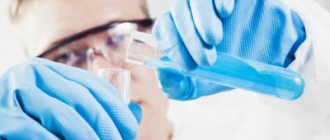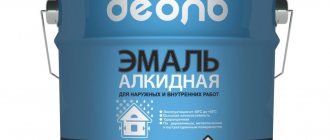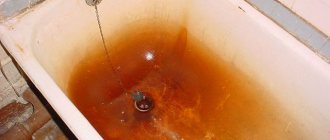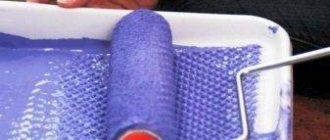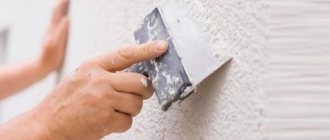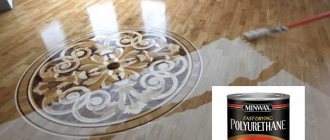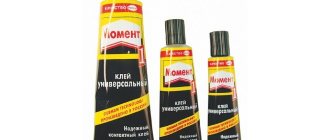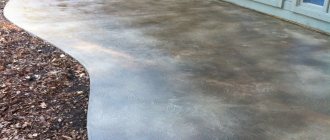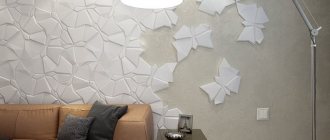Astrohim
Price 140 rubles.
The rating of the rust converter of the domestic company AstroChem continues. This is a budget analogue of foreign products in the low price segment. A half-liter container is enough for a decent area of metal.
The classic composition is supplemented with highly effective additives, zinc ions, which guarantees an impeccable work result, plus it has the property of restoring microcracks.
The second part of the formula, orthophosphoric acid, has an active effect directly on the source of rust, completely neutralizing the harmful manifestation. Also pleasing is the ease of subsequent processing - just wipe the surface thoroughly with special towels, then the preparation forms a galvanized layer.
Before painting, it is recommended to thoroughly remove the cleaner from the surfaces to be painted. Such parameters guarantee the possibility of gentle removal of defects in body parts.
Advantages:
- minimum price tag;
- worthy fulfillment of assigned tasks;
- large bottle volume.
Flaws:
Meticulous removal of the layer is required before painting.
Compound
Zinkar's composition includes the following components:
- phosphoric acid;
- complexing agent;
- manganese and zinc compounds;
- water.
Phosphoric acid is the main active ingredient responsible for the transformation of rust. The complexing agent maintains the consistency of the drug and is a binding component.
Phosphates form a reliable protective coating on the surface:
- zinc protects against electrochemical corrosion;
- manganese is responsible for surface alloying.
Rust remover "Tsinkar" - description
The Tsinkar rust converter was first released in 1993 (Moscow), which specializes in cosmetics and car chemicals. It is designed to combat rust on any steel substrates that are susceptible to corrosion.
Compound
The composition is based on phosphoric acid, manganese and zinc, the latter being present in the form of salts. All elements are selected strictly according to the developed recipe, otherwise the properties of the solution will change.
Application area
“Tsinkar” has proven itself best when processing steel, but it also works on other metals and alloys that are susceptible to rust. The main purpose of application is the transformation and removal of foci of corrosion damage, as well as further protection of surfaces from the action of atmospheric and climatic factors. The composition can be used on a machine to clean individual elements, as well as on:
- other vehicles;
- roofs;
- garages;
- bridge supports;
- welds.
It can be used for household purposes to neutralize rust on tools and steel parts of mechanisms.
Impact on rust
The composition is capable of creating a protective film on the metal surface. After application, it destroys the oxide forms of iron, which are rust, transforming them into phosphates. Simultaneously with the participation of manganese, an alloying effect develops, while zinc is activated at the site of electrochemical corrosion, eliminating them. The result is the appearance of a durable, reliable protective layer on metal products.
Release form and consumption rate
The product is available in the form of a liquid, placed in small and medium-sized bottles with screw caps. This solution is intended for normal application with a brush, like paint. The capacity of the bottles is 60, 500, 1000 ml. “Tsinkar” is also sold in spray cans, which have a more convenient method of application by irrigating the products. For professional use, “Tsinkar” is produced in 10 liter canisters.
The consumption of the composition depends on the application method, the number of layers, and the severity of existing corrosion processes. 110-340 g of composition are consumed per square meter of base.
Price and place of purchase
You can purchase the Tsinkar rust converter in construction stores and auto chemical departments. In addition, the drug can be ordered from online stores.
The price depends on the place of purchase, as well as on the volume purchased. The minimum packaging of Zinkar is 60 ml, the maximum is 10 liter canisters.
Average cost:
- 60 ml costs around 40 rubles;
- 1 l – from 200 rubles;
- 10 l – from 1,500 rubles.
The best rust converters for cars
Rust converter for cars Nanoprotech “Super Anticorrosive”
The product is designed to protect metal surfaces and mechanisms from various negative influences. Thanks to the active components, it forms a moisture-repellent layer, which acts as a reliable protection against corrosion. The converter does not require too frequent use, as it operates for quite a long time. We can talk about high heat resistance.
The composition can be used when preserving cars for a long period. It successfully copes with long-term protection against corrosion and all forms of moisture. After application, we can talk about high adhesion to metal.
This is where unique nanoparticles work, capable of penetrating deeply into the structure of the surface being treated. They literally push out moisture and remove rust and oxides. Operating temperature: -80 – +140 degrees. Packaging – 210 ml bottle. Price – from 239 rubles. One cylinder is enough to treat two squares of surface.
Pros:
- harmless;
- really works;
- withstands washing with chemicals;
- easily penetrates into hard-to-reach places;
- works on wet surfaces;
- maintains elasticity for a long time;
- versatility (cars, trucks, motorcycles, construction, agricultural equipment, etc.).
Minuses:
high consumption.
Rust converter for Zinkor cars ZINCOR
Zinkor promises molecular corrosion protection and we can say that this is a truly worthwhile product that does its job perfectly. The kit is designed for local galvanizing of a car body; it works to remove rust and clean chrome areas.
We can say that this is a traveling kit that provides electrochemical removal of corrosion and application of a protective zinc layer using the electrolytic method. One set is enough to process one square meter of body. Work is carried out from any starting charger or car battery.
All detailed recommendations are given in the instructions; I will only note that the solutions in the bottles are intended for reusable use and are non-volatile. One kit includes: a solution for applying a protective layer, a solution for removing rust and degreasing, a connecting wire, two electrodes - for preparing the surface and for applying protection. The asking price is from 840 rubles.
Pros:
- the product works effectively in practice;
- two in one: rust removal + protective layer;
- low consumption.
Minuses:
- manipulations with wires and bottles during application;
- high price.
Rust converter for cars Hi-Gear HG5718 aerosol
Rust converter is great for coating corroded metal surfaces. It is easy to use during body repairs and before painting. The product formula does not allow the development of under-film corrosion.
The composition is distributed throughout the metal and triggers a chemical transformation. After application, a durable protective layer of dark color is formed, ensuring strong adhesion of paints and varnishes. The product can be used at temperatures above +10 degrees. It is distributed over a dry, cleaned surface. Before doing this, the bottle should be shaken, and it is also shaken periodically during use.
Spraying is carried out until a uniform coating is obtained, maintaining a distance of 15-30 cm. A total of 2-3 layers are required. Layer drying takes 2-3 minutes. Excess is easily eliminated with alcohol. Packaging – aerosol bottle, volume – 255 g. Cost – from 571 rub.
Pros:
- copes well with converting rust into soil;
- forms a protective layer that is resistant to moisture;
- excellent for painting;
- easy application.
Minuses:
- high price;
- high consumption.
Analogs
In order to cope with rust, you can use other anti-corrosion drugs. Among the market leaders are converters of domestic and foreign production.
Sonax Rost Umwandler&Grundierung
Sonax is a rust preventative that is designed for minor body work and to combat corrosion on small areas of metal. This product works well when it is necessary to loosen nuts and bolts.
The composition of the converter is selected in such a way that it can be used even on areas covered with paint. Despite this, Sonax is toxic.
After drying on the metal surface, the product forms a polymer protective film . It can serve as a primer before applying paint.
When purchasing Sonax, keep in mind that the packaging is small and multiple bottles may be needed for extensive work. The cost of one is from 230 rubles.
Chainmail
Chain mail is a product of a domestic manufacturer. The product contains zinc, which creates a protective coating. The converter fights corrosion well and protects the metal.
There are no acids in Kolchuga . Serving as a primer at the same time, this product does not require rinsing before applying paint.
Another important plus is the affordable price. The cost of one bottle is around 130 rubles.
Hi-Gear Rust Treatment
Not every rust converter can cope with severe corrosion. But Hi-Gear successfully removes damage. The bottle is equipped with a sprayer, which allows you to treat even large areas of metal very quickly. As a result of the reaction, corrosion is eliminated, and a polymer layer is formed on the metal surface.
Hi-Gear must be used carefully, protecting the respiratory tract and avoiding contact with painted areas . The converter requires washing, not just with water, but with an alcohol-containing solvent.
This effective remedy is not cheap - 700 rubles.
Types of rust modifiers
There is a qualification of converters according to the form of release. Products are available in cans, liquid, paste and gel. Aerosols can be equipped with a flexible nozzle; it helps to easily apply the substance to any hard-to-reach places. If you need to treat a large area, then it is more rational to give preference to liquid or thick types; they can be applied with a brush or spray.
There is also a division of funds according to the principle of action and constituent components.
If you need to treat a large area, then it is more rational to give preference to liquid or thick types.
Acid converters
This group of corrosion converters has the largest size. Most of the solutions included in the group for removing corrosive areas are made on the basis of phosphoric acid. It promotes the transformation of iron oxide into iron phosphate, which no longer has a detrimental effect on the metal surface and is easily washed off.
There are several advantages of acid products:
- Possibility of use at any stage of metal damage;
- Suitable for use on thin and thick metal, used on car bodies, metal structures, household appliances;
- The ability to cope with the task even at low temperatures; their effectiveness does not decrease from low-temperature exposure.
Possibility of use at any stage of metal rust damage.
Neutral converters
These are acid-free products based on tannin. They also convert iron oxide into inactive elements, while helping to improve the quality of adhesion of the metal material to various paints and varnishes.
To improve the penetration of the product into the structure of the material, specialized additives are added to them. It is acceptable to use them when working with ferrous and non-ferrous metals, alloys, and delicate objects; they are used for car bodies; they are also used to prepare iron for the process of concreting and processing with mastic.
The advantages are the following:
- Lack of acids, which eliminates the need to rinse off the product before using the item;
- Stronger effect due to the presence of special attachments;
- Obtaining deep impregnation, which helps fight a thick corrosive layer;
- Can be applied as a primer for metal;
- You can choose any type of tool;
- No harmful elements in the composition;
- Explosion and fire safety.
It is permissible to use them when working with ferrous and non-ferrous metals, alloys, delicate objects, and are used for car bodies.
Rust to soil converter
You can also find them called primers. The constituent components are tannic acid, organic polymers (ethylene glycol, butoxyethanol and others). They transfer iron oxide into the primer layer. Most often they are used when it is necessary to treat multi-layer corrosion, due to their powerful effect.
When the loose mass is washed off from a metal object, a protective coating is formed that prevents moisture, steam, and chemical elements from entering its structure. The surface gains better strength and resistance to mechanical loads, thereby increasing the service life of the structure.
Most often they are used when it is necessary to treat multi-layer corrosion, due to their powerful effect.
Rust converters with zinc
From the name it is clear that the basis of the product is zinc oxide. Zinc particles coat the surface of the metal, removing rust and creating an anti-corrosion layer. The surface must first be treated with sandpaper. Without this, the effect will be worse.
Zinc particles coat the surface of the metal, removing rust and creating an anti-corrosion layer.
How to improve efficiency?
When thinking about how to use Zinkar rust converter, it is worth paying attention to subtle points, failure to comply with which could result in all your efforts going down the drain.
The first and main one is the need for total cleaning of the area that needs to be treated. If obvious through corrosion and severely thinned metal is detected, it should be removed mechanically. If there is a lot of rust, it makes sense to work with a metal brush together with an angle grinder. However, it’s also not worth thinning the metal too much. If welding work is necessary, you must first carry it out, and only then apply layers of protection.
If the solution is used to treat external elements that are most exposed to snow, rain, dirt and reagents, it makes sense to do priming and painting in a special chamber. Naturally, the body must first be thoroughly dried.
ABOUT THE PRODUCT
Developed on the basis of zinc and manganese compounds. When it is used, an “active” protective zinc-manganese-phosphate coating is formed on the metal surface. Zinc “works” when pockets of electrochemical corrosion occur. Manganese creates a surface alloying effect.
Available in bottles with a capacity of 60 ml, 500 ml, 1000 ml and in bottles with a capacity of 200 ml and 500 ml with a spray, as well as in 10-liter canisters.
HIT OF SALES IN THE RUSSIAN MARKET!
Rust converter “TSINKAR” is an exclusive product from AGAT-AUTO, which has no analogues on the Russian market. Produced since 2002, it is in high demand and provides a stable annual increase in sales.
SIMPLE and EFFECTIVE TO USE!
Modern methods of protecting metals from corrosion can be roughly divided into two large groups. The first is electrochemical protection: the creation of galvanic couples and corresponding electrical potentials, where a more active metal acts as a “protector” - it itself is destroyed, protecting the steel structure. The second is conservation methods of protection, creating an additional protective layer on the metal surface (for example: applying paint and varnish). To be fair, it must be said that electrochemical protection, as a rule, is not used in its pure form, as a mandatory addition to it - preservation of the surface of a steel structure.
Rust converter “ZINKAR” is a product in which we managed to combine the advantages of two areas of corrosion protection. Combining this does not mean getting “two” by simple addition: “one” plus “one”. In our case, this is finding the optimal ratio of the components included in the composition: orthophosphoric acid, certain salts of ZINC and MANGANESE, organic additives.
When the drug is applied to a metal surface, the oxide forms of iron are destroyed and converted into phosphates, while reactions involving zinc and manganese occur simultaneously. The result is the creation on the surface of a steel structure of a simultaneously durable and at the same time “active” complex-element protective layer. The ingredients included in “ZINKAR” must be in strictly defined proportions! Since their redistribution in the process of forming a protective coating is the “key” to the effectiveness of the ZINKAR rust converter, which combines galvano-potentiometric and mechanical-strength protection properties.
Application area:
“Tsinkar” is intended for processing metal (steel) surfaces in order to remove (transform) corrosion lesions (rust) and protect the treated surfaces from subsequent atmospheric and climatic influences. Products (structures) made of steel are subject to processing: garages, roofs, cars, trusses (supports) of bridges and overpasses, products with welded seams, riveted joints. The treatment is carried out before painting or applying other protective coatings.
Product effectiveness:
Due to the active components, the effectiveness of this drug is 2–4 times higher than “Rust converters” of a monophosphate composition (widely presented on the Russian market). “Active” zinc and manganese form a durable protective layer on the surface being treated. At the same time, zinc “works” when foci of electrochemical corrosion occur; manganese creates the effect of alloying the surface and strengthens the protective layer, which is not observed when using monophosphate compounds.
Consumption rates:
Single treatment of 1 m2 – 110–340 g. Consumption depends on the method of application and the condition of the surface being treated.
ATTENTION CONSUMERS! The product is available in plastic bottles with a capacity of 500 ml and 1 liter (10 l canisters), there is an option with a spray (trigger).
Its advantages: • ease of use, • more uniform distribution of the product over the surface, • savings on the preparation, • the ability to treat hidden cavities and hard-to-reach surfaces (for example: ceilings, remote surfaces, etc.).
ABOUT THE PRODUCT
ABOUT THE PRODUCT Developed on the basis of zinc and manganese compounds. When it is used, an “active” protective zinc-manganese-phosphate coating is formed on the metal surface. Zinc “works”
Priming and protecting the body after using the converter
To reduce the cost of future body repairs, good protection should be used. Immediately after treatment with this product and drying of the body parts, welding work can be carried out. It is important to treat all exposed areas so that they do not rust or deteriorate over time. During the processing process, fairly simple and effective solutions are used. After treatment with Zinkar, protection is performed as follows:
- a primer should be applied to all treated surfaces of the car, choosing a good protective material;
- when applying, it is important to remember the need to apply additional protective materials on top;
- if we are talking about external external parts, priming and subsequent painting must be done in a chamber;
- if the body is not properly dried before priming, it will not be possible to properly treat and protect the surface;
- The quality of the primer must be very high, since already damaged parts easily rust at the first opportunity.
Of course, a rust converter is not a panacea. Rather, this is one of the possible emergency methods of solving the problem. In most situations, service technicians prefer to carry out welding work. This ensures higher quality and good reliability of repairs. However, welding areas should also be treated to protect against corrosion. In any case, repair areas have a high risk of damage in the near future.
Features of using anti-rust products
Even if you follow the instructions strictly, using a rust converter does not always give the desired effect. To effectively and permanently get rid of corrosion, it is recommended to adhere to the following rules:
- use only proven brands of auto chemicals;
- before processing, try to clean the metal as well as possible (as far as possible);
- apply “anti-rust” with a brush, thoroughly rubbing in the liquid, do this even if the converter is applied by spraying;
- after drying, it is recommended to carefully remove any remaining product from the metal surface;
- carry out processing at least twice, and the more, the better.
Such domestic compounds as “Tsinkar”, “Kolchuga” (), and the B-52 rust destroyer have proven themselves to be good. The last of these products is produced in the form of a gel, so it is used more economically during application and has better contact with the metal.
After carrying out work to remove rust and wash off the remaining composition, it is necessary to apply primer; paint will not adhere normally to a “bare” metal surface.
Safety requirements
If the recommendations for safe operation are followed, Zinkar does not cause problems during application and storage. It also contains orthophosphoric acid, a flammable combustible substance, and therefore you should work away from fire and heat sources. In order not to harm human health, the room should be provided with high-quality ventilation, and all actions should be carried out wearing gloves, respirators, and special clothing. If the product gets on the skin, wash it all with soapy water; if redness and pain appear, consult a doctor immediately.
Other recommendations for using the composition are as follows:
- Avoid heating above +55 degrees.
- Store exclusively in a dark place out of reach of children.
- Strictly avoid contact with mucous membranes and eyes.
Instructions for use
Preparatory stage and application of the drug
Before painting a metal surface, it is imperative to carry out preparatory measures. In no case should the product be applied without cleaning the loose type of rust, which begins to separate freely. To do this, you can use various methods - rub the product with brushes, sandpaper, abrasives, clean with scrapers, spatulas and knives. It is best to buy a special brush for metal, and for cleaning large surfaces, a grinding device or drill with a special attachment. The old layer of paint should be scraped off or even washed off without fail.
Very often, a sediment begins to form at the bottom of the Tsinkar product, and for this reason it should be shaken as well as possible before use. Compositions in cylinders should be sprayed without additional devices; for a solution in a container or canister, you will need a small container, a roller and a brush. Old surfaces should be pre-coated with a special primer for metal in a couple of layers.
After the preparatory stage, you can begin the main work, that is, apply the product, completely wetting the metal and allow the first layer to dry. After a grayish or white coating appears, they will go over it with a stiff brush to remove non-reacting elements, and then begin applying the next layer.
Each applied layer will help improve the protective qualities of the resulting anti-corrosion coating, and also enhance its chemical and physical properties. Usually only a couple of treatments are enough, but sometimes 3 or 4 layers are required (if Tsinkar is used in important areas, or those that are subject to wear). Only one treatment can be performed to remove the corrosion layer without the need for further protection of the steel.
Important points
Drying time
One coat of product will take approximately 30 to 40 minutes to dry. The exact time will depend on the method of application, as well as environmental conditions (the given data in the form of numbers will be typical for room temperature). After drying, the final surface treatment should begin.
Should Tsinkar be washed off after application?
So, the dry metal surface should first be wiped with an old soft cloth. Next, you can begin to wash off the composition, and this should be done without fail, and only then the effectiveness of use will be very high. After washing, it is worth removing the resulting deposit, which forms as a result of the converter drying out. If you skip this stage, the metal under the layer of plaque will continue to rust. So, before applying the Zinkar rust converter, you should wash it with a concentrated solution of white alcohol, soda ash and silicone remover. If you have a soft sponge, you can use it to rinse the base with clean water, but without applying much force so as not to spoil the film. Then, after washing the product and drying it, you can paint it, if necessary. Typically, painting work is done to make the structure look more beautiful.
Priming and protecting the body after using the converter
How to increase the effectiveness of using the composition
To make the result of metal surface treatment more durable and of higher quality, the following tips should be followed:
- Do not ignore the preparation of the base and remove layers of rust, removing even the smallest stains.
- Do not apply products at high levels of air humidity or on products that are very wet.
- Do not make the coating very thick.
- Do not forget about washing off the solution with soda or other means.
And now a little about the rules of application.
How can you replace “Tsinkar”
There are many products similar to this rust converter that are sold. If the oxide layer is small, try making the following composition at home:
- mix water and citric acid in equal proportions;
- add a tablespoon of alkali, that is, ordinary baking soda, to the solution;
- wait 30-40 minutes;
- treat the surface with the resulting composition, dry and rinse it;
- coat the metal with primer and paint well.
Now you know how to use the Tsinkar product correctly. If the instructions are strictly followed, even novice craftsmen should not have any problems. You just need to strictly follow precautions and protect the skin and mucous membranes from burns.
Rust converter "ZINKAR"
This is a product in which we managed to combine the advantages of two areas of corrosion protection that we have conventionally defined. Combining this does not mean getting “two” by simply adding “one plus one”, etc. In our case, this is finding the optimal ratio of the components included in the composition: orthophosphoric acid, certain Zinc and Manganese salts.
When the drug is applied to a metal surface, the oxide forms of iron are destroyed and converted into phosphates, while reactions involving zinc and manganese occur simultaneously. The result is the creation on the surface of a steel structure of a simultaneously durable and at the same time “active” complex-element protective layer
It is necessary to emphasize once again: the ingredients included in “ZINKAR” must be in strictly defined proportions! Since their redistribution in the process of forming a protective coating is the “key” to the effectiveness of the “ZINKAR” rust converter
In the process of working on the composition, previously developed and currently used preparations were studied and evaluated, numerous experiments were conducted, and patterns of influence of additives (organic and inorganic) on the protective properties of the resulting coatings were identified. The result of the work is the rust converter “ZINKAR”, which combines galvanic-potentiometric and mechanical-strength protection properties.
Attention consumers! After completing a series of tests with positive results, in November 2006, along with the usual bottle, “Tsinkar” was released in a bottle with a spray. The color of the bottle has not changed (orange-yellow), the shape of the bottle is for easy grip and holding in the hand.
Its advantages: – ease of use, – more uniform distribution of the product over the surface, – savings on the preparation, – the ability to treat hidden cavities and hard-to-reach surfaces (for example: ceilings, remote surfaces, etc.).
Scope of application The Tsinkar rust converter is intended for processing metal (steel) surfaces in order to remove (transform) corrosion lesions (rust) and protect the treated surfaces from subsequent atmospheric and climatic influences.
The following steel products (structures) are subject to processing: garages, roofs, cars, trusses (supports) of bridges and overpasses, products with welded seams, riveted joints. The treatment is carried out before painting or applying other protective coatings.
Composition A product based on purified orthophosphoric acid with the addition of active ingredients in strictly regulated proportions: zinc and manganese compounds.
Efficiency of the product Due to the active components, the effectiveness of this drug is 2-2.5 times higher than “Rust converters” of a monophosphate composition (widely presented on the Russian market).
“Active” zinc and manganese form a durable protective layer on the surface being treated. At the same time, zinc “works” when foci of electrochemical corrosion occur; manganese creates the effect of alloying the surface and strengthens the protective layer, which is not observed when using monophosphate compounds.
Method of application: • Clean the metal surface from loose (flaking) rust • Apply the product to the surface with a brush, roller or spray method • Leave until dry • Repeat treatment (if necessary) • After drying (the last treatment), it is enough to wipe the surface with a dry rag or brush ( to remove residual plaque) • Treatment can be repeated one to several times. With each subsequent treatment, physical and chemical strength increases • Average treatment option 2 • The surface is ready for painting • The procedure for applying paints or other coatings after treatment with Zinkar in accordance with their instructions for their use.
Safety precautions Protect eyes and skin from direct contact with the product. In case of contact, rinse immediately with plenty of water. Work in a well-ventilated area. The Tsinkar rust converter is not flammable.
Consumption rates: – Single treatment 1 m2 110–340 g – Consumption depends on the method of application.
Rust converter "ZINKAR"
This is a product in which we managed to combine the advantages of two areas of corrosion protection that we have conventionally defined.
Advantages of the drug
In comparison with other methods of combating corrosion, the use of the drug “Tsinkar” guarantees the user the following advantages:
- uniform distribution of the composition over the treated steel surface, which guarantees economical material consumption and processing efficiency;
- the presence of a sprayer provides the ability to treat hard-to-reach surfaces and hidden cavities;
- the product does not contain flammable or combustion-supporting components;
- ease of use and its very reasonable cost.
Operating principle of converters and their composition
There are various products on sale that belong to the group of rust converters. All of them, despite the different components in their composition, work on a similar principle - they transform iron oxide into chemically inert substances. Most often, the composition of the converters is represented by orthophosphoric acid - the antipode of rust, or other acids. Such chemical elements actively react with the corrosion layer and convert it into salts, which can be easily removed from the surface of the metal product. Acid products have one disadvantage: if they are not washed off the surface after work, they themselves can become a source of corrosion.
To get rid of rust on metal and prevent its development in the future, more advanced compositions have been developed. These may include:
- Corrosion inhibitors. They protect metal bases from water, temperature changes, and aggressive chemicals for a long time. Most often, zinc acts as a corrosion inhibitor. This chemical element binds with oxygen atoms, resulting in the formation of a durable film that reliably protects carbon steel and stainless steel from destruction. In addition to zinc, manganese or tannin can act as a corrosion inhibitor.
- Thickeners. These synthetic substances are included in rust converters to facilitate application and retention on the surface. Without thickeners, the product will drain from a vertical or inclined base, and the effect will not be fully manifested.
The converters may contain additional substances - film formers, flavoring agents, various additives that enhance the effect of the main elements.
Advantages and disadvantages of "Tsinkar"
The product has a lot of advantages, and one of them is the ability to use it for a wide range of products, ranging from a variety of vehicles to household appliances and complex structures. Other benefits are:
- convenience and ease of application;
- affordable price and low consumption;
- availability of the composition in containers of different sizes;
- the ability to treat hard-to-reach areas and hidden cavities using a spray composition;
- no harmful effects on elements and parts;
- highly effective against rust and to prevent its occurrence in the future.
The product also has disadvantages. The instructions for applying it must be strictly followed, otherwise the desired result will not be achieved. The composition is suitable only for early and medium degrees of metal damage by corrosion, and in case of severe destruction it is better to use welding. The composition is toxic, and it is necessary to work with it carefully, observing personal protective measures.
How is Zinkar used?
What is car plasticine with a rust converter and how to use it?
The metal surface to be treated must be thoroughly cleaned of all existing rusty deposits. Any abrasive means is suitable for this.
If necessary, additional processing is necessary
It is also important to pre-dry and clean the surface from contamination. If this is not done, then Tsinkar will have the opposite effect, and the surface will become even more rusty.
Applying the product to a plane
The disadvantage of this method is that it is not always possible to reach the right places with a roller. Spraying Zinkar will be more effective.
In this way, you can treat hidden and hard-to-reach surfaces of a car and other structures.
